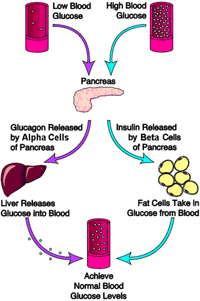
Glucagon and insulin balance or equilibrium.
Glucagon is a hormone produced by the alpha cells of the pancreas. Its effect is the opposite to insulin[1] -- it causes the liver to release stored glucose into the blood, raising blood glucose levels. This process is called glycogenolysis. Glucagon is the main counterregulatory hormone to insulin[2].
Glucagon and insulin, in a healthy animal, form an equilibrium[3] that regulates blood sugar levels[4][5]. In a diabetic, the equilibrium mechanism is often seriously skewed or completely broken[6].
The hormone is used at times for hypoglycemia treatment[7], since it causes the liver to release its stores of glycogen, which the body turns into glucose[8]. Treating hypoglycemia with glucagon will be unsuccessful if the liver's glycogen stores are depleted, because there would be nothing available for release[9].
Glucagon release at low, or fast-dropping blood sugar levels is known as Somogyi rebound.
Further Reading[]
- Article on Glucagon/Insulin equilibrium
- Illustration of the actions of insulin and glucagon in the body.
- Intervet-Caninsulin UK-Diagram of Glucagon Metabolism
References[]
- ↑ Intervet-Caninsulin UK-Glucose Metabolism
- ↑ The Genetic Landscape of Diabetes
- ↑ Colorado State University: Physiologic Effects of Glucagon
- ↑ Intervet-Caninsulin UK-Insulin & Glucagon--Glucose Metabolism
- ↑ Intervet-Caninsulin UK-Diagram of Glucose Metabolism
- ↑ Intervet-Caninsulin UK-Pathophysiology of Diabetes Mellitus-What Happens With Insufficient Insulin
- ↑ Southpaws.com-Fall, 2000-Glucagon Infusions
- ↑ BD Diabetes- FAQ's About Diabetic Dogs-Dr. Greco
- ↑ Ineffectivity of Glucagon When Liver Glycogen Stores Are Depleted